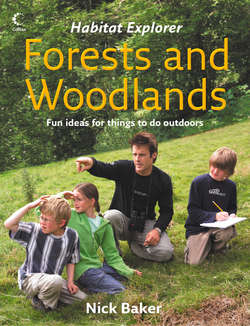Читать книгу Forests and Woodlands - Nick Baker - Страница 10
The texture of bark
ОглавлениеAnother distinguishing feature of a tree, and one that remains even in the winter when most leaves would have dropped, is the texture of the bark. The quickest and easiest way to record this is to make a rubbing – see Nick’s trick, below. The other way of recording your tree requires a little more effort, but it produces a really smart, three-dimensional model of a section of tree trunk – and that is by making a cast of it (see opposite).
Hold the crayon or pastel on its side for the most effective technique. This really helps to bring out the textures underneath.
Nick’s trick
* Carefully tape a piece of paper to the trunk of the tree and then colour over it with a crayon or pencil (dark looks best on white paper, but white chalk on black paper is pretty stylish, too).
* In this way you record all those textures and patterns and soon you will start to recognize a combination of these features and the colours. I have a friend who is a blind naturalist and he can tell most species of tree by these very textures you will be recording with your rubbings.
YOU WILL NEED
> modelling clay
> strong cardboard box
> plaster of Paris
> water
> poster paints
> paintbrush
1 First find the tree you wish to make an impression of. Then knead and pummel your modelling clay so it is soft and free of air bubbles. This makes it much easier to work with and gives you a better impression at the end.
2 Firmly press the clay into the tree’s surface. Try to keep the clay at least 1.5cm thick and aim to keep the edges from tapering. If you are going to make many such casts for a collection, use standard dimensions at this point as it makes the casts easier to store and/or mount.
3 Peel away the clay and you will notice all the bark textures on it. You now have to get this home without damaging the mould, so this is where a stout box to transport the clay comes in handy.
4 Once back at base, place the mould with the textured surface uppermost. Then use more modelling clay to make a ridge at least 2.5cm higher than the mould. You can choose at this point whether to make a curved cast, like the profile of the tree, or a flat section.
5 Following the packet’s instructions, mix some plaster of Paris with water. Pour the plaster into the mould and leave to set for a few hours. Then carefully lift and peel away the modelling clay to leave your bark cast, ready for display.
6 If you like, you can paint your bark impression with poster paints so that it looks even more lifelike.
